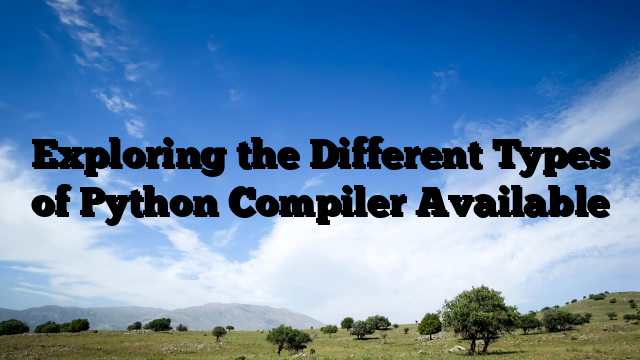- Exploring the Amazing Python Features
- Understanding Memory Management in Python: A Comprehensive Guide
- Exploring the Benefits of Python Programming
- Exploring the Best IDE for Python Programming
- Java or Python: Which Language Holds the Key to Your Programming Success?
- PHP vs Python: Which Language is Best for Your Project?
- From Bugs to Brilliance: Harnessing Python Exceptions for Powerful Coding
- Types of inheritance in python
- How to Create an Android App with Python
- Python vs C++: Uncovering the Best Programming Language for Your Needs
- How should I start learning Python?
- Python Dictionary: A Comprehensive Guide to Understanding and Using Dictionaries
- Introduction to Python Generators: What They Are and How to Use Them
- A Comprehensive Guide to Understanding Python else if Statements for Optimal Decision Making
- Boost Your Programming Skills with Python NumPy: An In-Depth Exploration of Its Features
- Exploring the Different Types of Python Compiler Available
- Understanding Python Tuples: A Comprehensive Guide
- Python List: A Comprehensive Guide to Working with Lists in Python
- Exploring Logical Operators in Python: A Comprehensive Guide
- Exploring the Different Types of Python Operators: A Comprehensive Guide
- A Comprehensive Guide to Python Datatypes
- Introduction to Python for Beginners
- Python Download: Your Comprehensive Guide to Getting Started
- how to comment out multiple lines in python
Introduction
Python, a popular and versatile programming language, has gained tremendous popularity for its simplicity, readability, and vast array of libraries and frameworks. Whether you are a beginner or an experienced developer, Python offers endless possibilities for your coding endeavors. In this comprehensive guide, we’ll walk you through the process of Python download, explore its various versions, and provide valuable insights to help you embark on your Python journey with confidence.
Python Download: Step-by-Step Guide
Step 1: Choose the Right Version
Before starting the Python download process, you need to decide which version best suits your needs. Python has two major versions – Python 2 and Python 3. However, Python 2 is no longer actively maintained, and Python 3 is the recommended choice for new projects. Choose the latest Python 3.x version for optimal performance and access to the latest features.
Step 2: Download Python
To download Python, follow these simple steps:
- Visit the official Python website at https://www.python.org/downloads/.
- Click on the “Downloads” tab, and you’ll find the latest Python version available for your operating system (Windows, macOS, or Linux).
- Click on the appropriate installer, and the download will begin automatically.
- Once the download is complete, run the installer, and the Python setup wizard will guide you through the installation process.
- Remember to check the “Add Python to PATH” option during installation to ensure Python is easily accessible from the command line.
Step 3: Verify the Installation
After completing the Python download and installation, it’s essential to verify that Python is correctly set up on your system. Open your terminal or command prompt and type “python –version.” If the Python version is displayed, congratulations, you’ve successfully installed Python!
Python Versions: A Brief Overview
Python has seen several major releases over the years, each introducing new features and improvements. Let’s explore some of the significant Python versions:
Python 2.x Series
Python 2 was released in 2000 and became widely popular, but it reached its end-of-life in January 2020. Despite its legacy, Python 2 should no longer be used for new projects due to discontinued support and security risks.
Python 3.x Series
Python 3 was introduced in 2008, addressing various design flaws and making the language more consistent and efficient. Python 3 is the future of Python and is continually evolving with new features and enhancements.
Python Download for Specific Versions
For certain projects or compatibility requirements, you might need to download specific Python versions. You can find older Python releases at https://www.python.org/downloads/release/python-xyz/, where “xyz” denotes the desired version number.
Python Download: FAQs
How can I check if Python is installed on my system?
To check if Python is installed, open the terminal or command prompt and type “python –version.” If Python is installed, it will display the version number.
Can I have multiple Python versions installed on my computer?
Yes, you can have multiple Python versions installed on your computer. However, ensure that the Python version you intend to use is correctly configured in your system’s PATH.
Is Python download free?
Yes, Python is an open-source programming language and is available for free download on the official Python website.
Can I download Python on mobile devices?
Python is primarily designed for desktop operating systems, but there are certain mobile applications and IDEs that allow you to run Python code on mobile devices.
What is the recommended Python version for beginners?
For beginners, Python 3 is highly recommended as it is the latest version with active community support and regular updates.
Is it necessary to add Python to the PATH during installation?
Adding Python to the PATH during installation is not mandatory but recommended. It allows you to run Python commands from any location in the terminal or command prompt.
Conclusion
Congratulations! You’ve successfully completed your Python download and are now ready to embark on an exciting coding journey with Python. This versatile language offers limitless possibilities for web development, data analysis, artificial intelligence, and more. Explore the vast Python community, experiment with different libraries, and contribute to this ever-growing ecosystem.
Remember, learning Python is a continuous process. Stay curious, practice regularly, and seek guidance from online resources and tutorials. As you dive deeper into Python, you’ll discover its true potential and become part of a thriving community of developers worldwide.
So, go ahead and start your Python adventure today! Happy coding!
============================================
Python download, Python installer, Latest Python version, Python download for Windows, Python download for macOS, Python download for Linux, Python 3 download, Python 2 download, Download Python for beginners, Python setup download, Python interpreter download, Python software download, Python IDE download, Python programming download, Python development download, Python download for data science, Python download for web development, Python download for machine learning, Python download for artificial intelligence, Python download for scientific computing, Python download for automation, Python download for game development, Python download for mobile app development, Python download for backend development, Python download for frontend development.

















